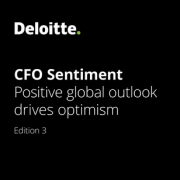Q&A WITH GEOFF ROONEY CFTP
Senior Manager Financial Services,
EY
Tell us a bit about yourself
I am a Senior Manager in EY’s Financial Services Office based in Sydney. My role focuses on advising and providing assurance to financial institutions and corporate treasury departments. I love treasury, finance, capital markets and the broader financial services and wealth management industry.
I am a Chartered Accountant, Member of the FTA, AMCT and Association of Corporate Treasurers, UK. I am a degree qualified RG146 compliant financial planner, so I would say I am not afraid of some additional study.
Q1: What is the size of your team and what is the one thing you do well collectively?
We have 15 in our team across Sydney and Melbourne. We are a fast paced group of people with many projects underway at any one time, so juggling multiple deadlines and constant stakeholder management is something that is a daily challenge. Our team culture is strong, and has been forged by hiring the right people, regular team meetings and brain storming sessions as well as planned social activities. These all help to make sure that the workload is shared, and the team communicates seamlessly.
Q2: As someone who works closely with Treasurers and Treasury teams, what do you see as the challenges and opportunities facing the profession now and into the future?
Treasurers are being asked now more than ever to do more with less.
For many organisations it is difficult get the right people, with the right skills and then, once you have them, to retain them is a constant battle. With the increasing number of Millennials in the work force, and the ongoing trend for finance transformation this is only set to continue.
Treasury reporting is also a common challenge. Is less more, or is the devil in the detail? Do you have standard reports, or constant monthly customisation for current issues and themes? This struggle is increased by an often continual need to reconcile multiple data sources, combined with some board and audit committee members with varying levels of treasury knowledge.
While these are but two examples of challenges that treasury professional face, they are not going to go away any time soon. They do however present some opportunities for treasury professionals. I see these opportunities as;
- We as treasury professionals have the opportunity to redefine what the treasury career path of the next generation will be. What will attract, retain and enrich the next group of treasury professionals and how will they help us all to have stronger influence as a collective is open for us to define.
- With treasurers being asked to take on broader roles within organisations, and review historic treasury reporting, we as treasury professionals are well placed to be effective change agents across organisations. With the core skill set of financial risk management, the ability to help empower the broader business, and those charged with governance to better understand the risk and rewards of business activities more fully, ultimately add to the bottom line.
Q3: Roles are evolving and technology is challenging our way of working. Do you agree and how are you adapting to the change?
There is no escape from technology, it will only continue to increase in its prevalence in all our workplaces and lives. Rather than trying to ignore technology or work around it, working to embrace the change will put people that do, in the driver’s seat. Cloud computing, cyber security risks, big data, Robotic Process Automation are all items that need to be on the mind of treasury professionals. As I mentioned above, we have a chance to redefine what the treasury profession is known for, and being able to use technology to quickly analyse and interrogate data to provide insight can only be a good thing. I would not want the profession to stand still and have our own Kodak moment
Q4: As a member of ACT how if any will the role of the Corporate Treasurer in Europe change as a result of Brexit?
Given the high level of uncertainty about what the economic environment looks like post the Brexit referendum there are few straightforward answers but there are questions that need to be considered for all treasurers. Not just those that are headquartered in the UK, but those that have subsidiaries in the UK, business units, banking counterparties or even contracts/customers within the UK.
Locally, to date most people have just been getting on with the usual reporting season impacts and considering, how the treat Brexit in CVA/DVA and basis risk impacts for 30 June valuations and your hedge effectiveness testing.
Over the longer term as the impacts become more clear, treasurers should work with their leadership team to consider the impacts across the treasury operating model including, governance, funding, cash management, risk management and working capital management.
Q5: What in your opinion the three major skills that makes a successful Treasurer?
1. Intelligence
2.Perserverience
3. Agility
Q6: On both a personal and professional level, what are you really passionate about?
I like getting out of my comfort zone. You learn so much more about who you are and what you can achieve when you are pushing yourself to do and try new things.
At work, I enjoy projects that are forward looking and where I can work with teams of enthusiastic people to find solutions to problems that have caused organisational pain or stress for some time.
Personally, I like adventure holidays, for example recently I have been tracking in Nepal, and Peru and also have travelled across India, and Papua New Guinea. I have also just finished my sailing skippers ticket/licence and so I am looking forward to planning some overseas sailing expeditions, potentially in Tonga, Cuba or New Zealand.






 The 2nd issue of the FTA’s Exchange Magazine is out now!
The 2nd issue of the FTA’s Exchange Magazine is out now!






